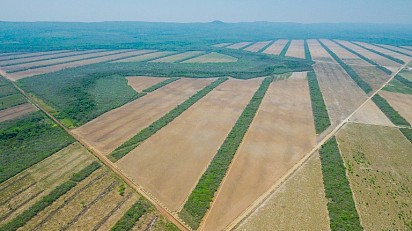Bolivia has a soy deforestation problem. It’s worse than previously thought.
 Mennonites, often searching for new land to expand their simple, rural lifestyles, have founded hundreds of communities across Latin America over the last century. In forested areas, particularly the Amazon, that’s become a problem when the communities clear trees to make room for agriculture — sometimes thousands of acres at a time.
Mennonites, often searching for new land to expand their simple, rural lifestyles, have founded hundreds of communities across Latin America over the last century. In forested areas, particularly the Amazon, that’s become a problem when the communities clear trees to make room for agriculture — sometimes thousands of acres at a time.
Bolivia has felt the brunt of the impact in recent years. Mennonite soy farms have been a main driver of deforestation in the Beni and Santa Cruz departments, where vulnerable areas like the dry forest biome of Chiquitanía are already suffering from drought and fires caused by climate change.
“What’s happened over the last thirty years is a consolidation of the Mennonites, which is also transforming the forest,” said Daniel Larrea, science and technology program coordinator with Conservación Amazonica in Bolivia.
Recently released satellite data shows that soy plantations were responsible for over 900,000 hectares (2.2 million acres) of deforestation between 2001 and 2021, or a land mass roughly the size of Vermont, according to two new reports from NGO Amazon Conservation. Mennonites were responsible for around a quarter of it, or 210,980 hectares (521,344 acres), with activity increasing in the last five years.
The figures come from a new Global Forest Watch data set on soy plantations, which was merged with forest loss imagery to determine soy-driven deforestation. Analysis of the data was conducted by Amazon Conservation’s Monitoring of the Amazon Project (MAAP).
Mennonites arrived to Bolivia in the 1950s but didn’t find a strong foothold in the country until the 1990s, when many of the communities started to expand through the legal acquisition of land titles. There’s no limit on the amount of land that a foreign resident can own in Bolivia, and many Mennonites have learned how to work quickly and legally in the country’s land purchasing system, according to Larrea.
“They haven’t overflowed into areas illegally,” he said. “The process is taking place through the legal acquisition of land, regularization, which is a little different from what happens in other countries.”
A lot of press coverage has been given to the soy industry in Brazil, where a moratorium has yielded debatable results in stopping deforestation. And more recently Peru has been the center of the debate on Mennonites, since they were largely responsible for clearing 4,000 hectares (10,000 acres) of forest between 2017 and 2021.
Some researchers believed Peru was experiencing the worst of the Mennonite forest loss problem and that any land occupied by similar communities in Bolivia was likely already degraded. But this new Global Forest Watch data set provides more nuance to the situation on the ground.
“It’s just really striking to see it on an even much more massive scale than in Peru,” Dr. Matt Finer, senior research specialist at Amazon Conservation and the Director of MAAP, told Mongabay about the situation in Bolivia.
Other soy plantations are owned and operated by local farmers and larger agricultural producers, which are also allegedly responsible for thousands of hectares of deforestation in the east and northeast regions of Bolivia.
“The Mennonites came with technological, organizational and probably financial capabilities that generated very extensive deforestation,” Senator Cecilia Requena told Mongabay. “However, they are by no means the only group.”
Requena said the fact that so many different kinds of groups can plant soy and clear the forest is a sign of the failure of the Bolivian government and its environmental policies. “The Bolivian state and — why not say it? — the Bolivian business community, Bolivian civil society, haven’t been able to avoid an ecological catastrophe that is expanding every day.”
You can return to the main Market News page, or press the Back button on your browser.

